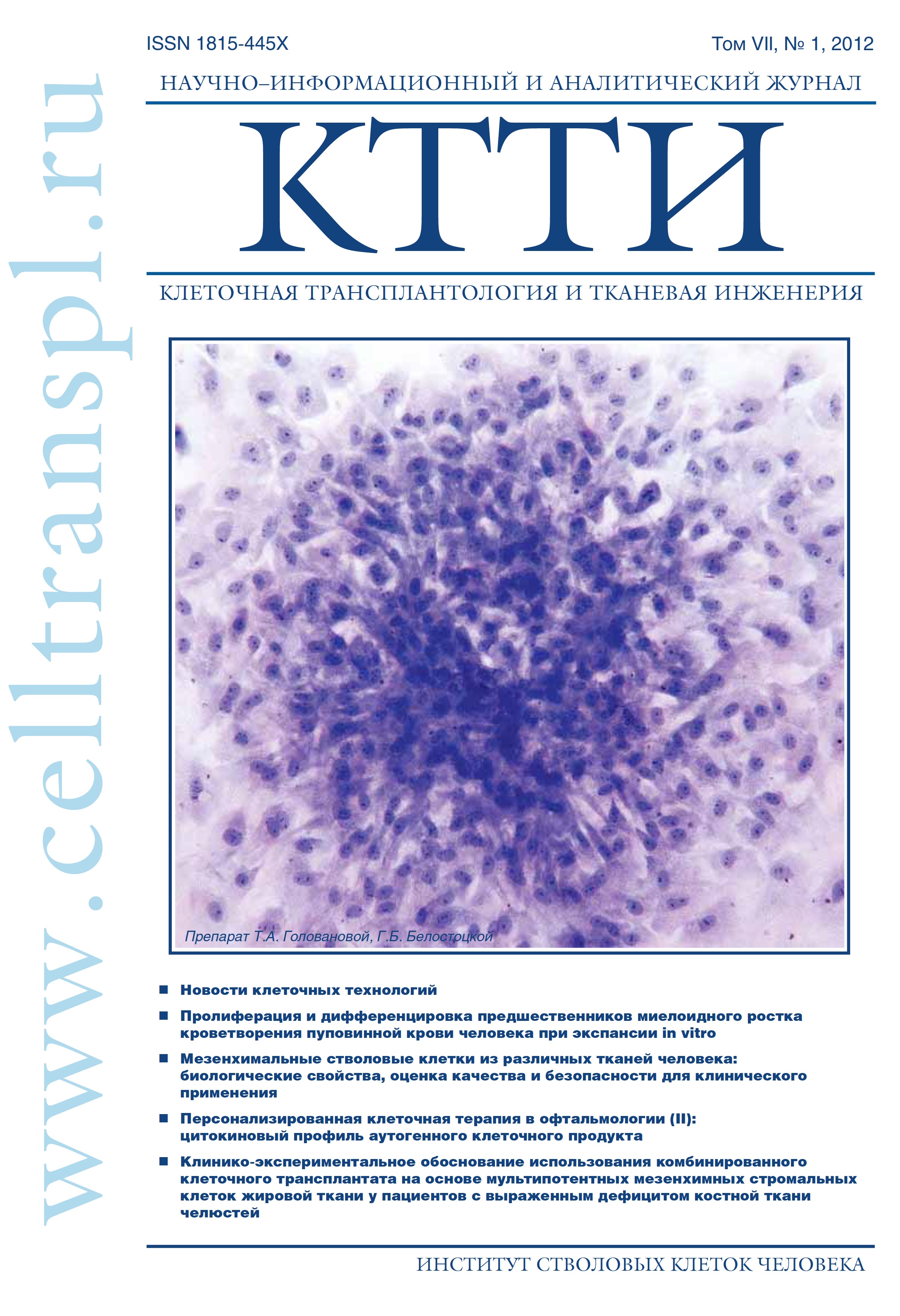Bio-photon mechanism of the activation of cellular programmes: a haemopoietic precursors proliferation
- Authors: Vladimirsky EB1, Milman VD1
-
Affiliations:
- Tel Aviv University, Israel
- Issue: Vol 7, No 1 (2012)
- Pages: 92-96
- Section: Articles
- Submitted: 11.01.2023
- Published: 15.03.2012
- URL: https://genescells.ru/2313-1829/article/view/121699
- DOI: https://doi.org/10.23868/gc121699
- ID: 121699
Cite item
Abstract
In this paper the bio-photonic mechanism of the activation
of cellular programmes is analyzed. Our basic hypothesis is
that cells and individual molecules radiate certain waves that
are close to monochromatic (i.e., have a narrow range of
radiation frequencies). The cell receptors, for their part, take
in certain monochromatic signals. In order to estimate the
value of the intensity of radiation it is necessary to refer to
the fundamental laws of electro-magnetic waves propagation
and photon emission.
The research was conducted using a model of the
haemopoietic precursors proliferation induction and the
apoptosis of the mononuclear cells of peripheral blood ex vivo.
The granulocytic colony-stimulating factor (G-CSF) in different
concentrations, including ultra-low (homeopathic) ones, was
used as the inductor of the proliferation and the inhibitor of
apoptosis. Some homeopathic preparations in high dilutions
were also included in the study. The study showed the high
efficacy of low and ultra-low (homeopathic) concentrations of
the preparations. This phenomenon may be explained with the
help of the destructive and constructive interference theory.
A calculation of the interaction of the monochromic waves
radiated by active molecules was done based on their size
and molecular mass as well as the size of the target cells.
The authors developed an original method of calculating the
effective concentration of the preparation.
of cellular programmes is analyzed. Our basic hypothesis is
that cells and individual molecules radiate certain waves that
are close to monochromatic (i.e., have a narrow range of
radiation frequencies). The cell receptors, for their part, take
in certain monochromatic signals. In order to estimate the
value of the intensity of radiation it is necessary to refer to
the fundamental laws of electro-magnetic waves propagation
and photon emission.
The research was conducted using a model of the
haemopoietic precursors proliferation induction and the
apoptosis of the mononuclear cells of peripheral blood ex vivo.
The granulocytic colony-stimulating factor (G-CSF) in different
concentrations, including ultra-low (homeopathic) ones, was
used as the inductor of the proliferation and the inhibitor of
apoptosis. Some homeopathic preparations in high dilutions
were also included in the study. The study showed the high
efficacy of low and ultra-low (homeopathic) concentrations of
the preparations. This phenomenon may be explained with the
help of the destructive and constructive interference theory.
A calculation of the interaction of the monochromic waves
radiated by active molecules was done based on their size
and molecular mass as well as the size of the target cells.
The authors developed an original method of calculating the
effective concentration of the preparation.
About the authors
E B Vladimirsky
Tel Aviv University, IsraelTel Aviv University, Israel
V D Milman
Tel Aviv University, IsraelTel Aviv University, Israel
References
- Владимирская Е.Б. Механизмы кроветворения и лейкемоге- неза. М.: Династия; 2007.
- Svoboda K., Reenstra W. Approaches to studyng cellular signaling. Anat.Rec., 2002; 269: 123-39.
- Alberti C. Cytoskeleton structure and dynamic behavior. Europ. Rev. Med. Pharmacol. Sci. 2009; 13: 13-21.
- Venter J.C., Adams M.D., Myers E.W. et al. The Sequence of the human genome. Science 2001; 291: 1304-51.
- Popp F.A., Chang J.J. The physical background and the informational character of biophoton emission. In: Chang J.J., Fish J., Popp F.A., editors. Dordrecht (Netherlands): Biophotons; 1998. p. 238-50.
- Gurwitsch A.G. Die Natur des spezifischen erregens der zellteilung. Entwicklungs Mechanik der Organismen 1923; 100: 11-40.
- Gurwitsch A.G., Gurwitsch L.D. Die mitogenetische strahlung. Jena (Germany): Fischer; 1959.
- VanWijk R., Van Aken J. M., Mei W. et al. Light-induced photon emission by mammalian cells. J. Photochem. Photobiol. 1993; 18: 75-9.
- VanWijk R. Bio-Photons and bio-communication. J. Sci. Explor. 2001; 15: 183-97.
- Popp F.A. Biophotonen. Heidelberg (Germany): Verlag fuer Medizin Dr. Ewald Fischer; 1976
- Karu T. Action spectra. Importance for low level light therapy. Photochem. Photobiol. 1999; 49(1): 1-17.
- Казначеев В.П., Михайлова Л.П. Биоинформационная функция естественных электромагнитных полей. Новосибирск: Наука; 1985.
- Albrecht-Buehler G. Rudimentary form of cellular vision. PNAS USA 1992; 89: 8288-92.
- Golantsev V.P., Koralenko S.G., Moltchanov A.A. et al. Lipid peroxidation, low-level chemiluminescence and regulation of secretion in the mammary gland. Experientia 1993; 49: 870-5.
- Shen X., Mei W., Xu X. Activation of neutrophils by a chemically separated but optically coupled neutrophil population undergoing respiratory burst. Experientia 1994; 50: 963-8.
- Tyner K., Kopelman R., Philbert M. «Nanosized Voltmeter» enabeles cellular-wide electric field mapping. Biophysical J. 2007; 93: 1163-74.
- Bokkon I., Salary V., Tuszynski J.A. et al. Estimation of the number of biophotons involved in the visual perception of single - object image: biophoton intensity can considerably higher inside cells than outside. Photoch. Photobiol. 2010; 100: 160-6.
- Томкевич М.С., Румянцев А.Г., Владимирская Е.Б. и др. Влияние гомеопатических средств на функциональную активность гемопоэтических предшественников. Гематол. и трансфузиол. 2000; 1: 11-3.
- Шарова О.В. Регулирующее влияние гомеопатических пре- паратов на процессы пролиферации и апоптоз клеток крови челове- ка [диссертация]. М.; 1999.
- Афанасьев Б., Зарицкий А., Забелина Т. и др. Колониеобра- зующая способность костного мозга в полутвердой культуральной среде. Физиология человека 1976; 2: 301-8.
- Корпачев В. Фундаментальные основы гомеопатической фармакологии. Киев: Четвертая хвиля; 2005.
Supplementary files










